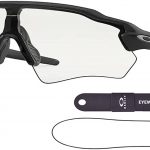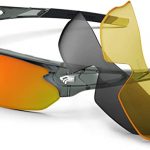Cycling glasses can range drastically in price. Some cost less than $20 while high-end options sell for over $200. There are a few key reasons mountain biking eyewear comes at such a premium price compared to regular sunglasses. Advanced frames, specialized lens technology, and extra features that enhance vision and protection are what make cycling glasses so costly.
Frame Materials
Most cheap sunglasses use basic plastic frames which are prone to breaking and don’t offer adjustments. Cycling glasses feature stronger, flexible, lightweight frames to better handle impacts and falls off-road. Brands construct frames from durable TR90 nylon, Grilamid, or polycarbonate composites. These maintain shape after hard crashes and allow tweaking of fit.
Higher-end brands like Oakley utilize proprietary substances like Unobtainium rubber for the ear and nose pads. This ensures a secure no-slip fit when sweating profusely grinding up climbs. Greater comfort means you can wear shades for longer rides without frequent repositioning. Premium cycling eyewear feels almost weightless on your face but holds firmly in place over the most aggressive terrain.
Lens Materials and Technology
Lens material is vital for optimized optics. Many discount options simply use basic polycarbonate which is impact resistant but low grade. Mountain biking lenses undergo brutal abuse from job site debris, errant branches, and mud. Brands like Smith Optics turn to carbonic material glass for best clarity and scratch resistance bike lenses can offer. Though more brittle than plastic, glass boasts unparalleled optical purity to better spot hazards on messy trails.
Lens innovation further enhances vision for cycling. Oakley prides itself on advancements like Prizm technology which fine tunes light transmission to amplify contrast, balance color tones, and let you read details like trail surfaces more clearly. Prizm was first developed to help athletes better perform their sport – seeing texture and contours means improved control and reaction times mountain biking. Often cheaper sunglasses can distort color and lack acuity which strains eyes trying to focus through them across hours out on demanding terrain. Upgrade lens technologies prevent this visual fatigue to keep you riding stronger for longer.
Premium Coating and Polarization
Another way brands make lenses clearer for cycling is applying premium anti-glare and fog coatings during production. These stop vision obscuring lens flare and prevent moisture build up which severely hampers visibility in dynamic outdoor light. Cyclists encounter non-stop glare when riding and cheaper factory coatings just don’t last miles on the trail. High-end options like the Smith ChromaPop Storm Brown Polarized lens combines industry leading hydrophobic and oleophobic coatings to almost totally negate issues like wetness and grease marks mucking your optics.
These lenses also implement polarization which filters specific light waves to cut through reflective glare. This further maximizes what mountain bikers actually need to see when tracking through sunlight and shadows under tree canopy. Less eye strain means less headaches and ability to ride longer with consistent sharp vision.
Advanced Protection
Better shielding your eyes from harm also costs more. Polycarbonate lenses found on most budget sunglasses provide basic protection. But manufacturers produce lenses like Smith’s Tapered Lens Technology which tapers frames around the eyes for extra coverage without heavy feel. This also amplifies your field of view for added safety spotting obstacles and other trail users approaching. Brands market lenses made of impact resistant photochromic material that transition tint based on conditions. This guarantees protection in both bright light and dark forests adapting shade instantly without needing swapping lenses manually.
Other models offer bonus lower Extended Vision areas to maximize what you catch peripherally. Bolle takes modulation even further on models like the Cobra MTB ensuring safe sight on gnarliest downhill terrain. An upper modular lens clicks onto a lower section securing tightly around the face covering more area protection from all angles. Modularity enables carrying an spare lens specific for variable or extreme light that can swap easily without returning the trailhead. The more lenses shield eyes the safer cyclists will be navigating unpredictable settings mountain biking.
Streamlined Fit
How glasses contour and fit your face also affects comfort and price. Standard cheap sunnasses are sized generics with limited adjustments at best. They don’t account for subtle distinctions in users’ proportions and bone structure. Premium cycling brands design models with ergonomic shaping around eye, nose and ear placement based on aggregate consumer data. This tweaks how the frame front angles, temple arm length, and other variables sit. The result is a feel disappearing seamlessly on your mug with less need to fuss adjusting so they stay put when riding aggro.
Streamlined fit interplays with balance and frame weight also. Brands obsess over grams shaved off to prevent unnecessary pressure that translates to pain after hours jostling over obstacles. Things like oakley’s ultra-lightweight wire core frames trim heft while retaining shape after impacts. This balances eyewear gently on your features without poking while still providing certified protection meeting ANSI Z87.1 safety standards. Lightness helps expensive cycling shades almost feel like part of your body so you can just focus on the ride.
At the end of day, price comes down to how optics and construction best serve a cyclist’s needs out on rugged trails. Superior vision, protection, fit, and comfort allow you to ride harder, longer without distraction or fatigue associated with bargain sunglasses not up to mountain biking demands. There’s a reason cheap gas station shades run $10 while high-performing lenses and frames tested on podium finishers sell over $200. But ultimately, using equipment that enhances your experience rather than detracts from it makes any sport more rewarding pursuit.





